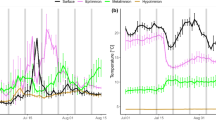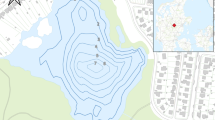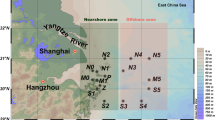Abstract
Lake eutrophication is a problem in many areas of Ontario, although the history of nutrient enrichment is poorly documented. The aim of this study was to construct a diatom-based transfer function to infer past phosphorus levels in Ontario lakes using paleolimnological analyses. The relationship between diatom assemblages and limnological conditions was explored from a survey of diatoms preserved in the surface sediments of 64 Southern Ontario lakes, spanning a total phosphorus gradient of 0.004 to 0.054 mg L-1. Over 420 diatom taxa were identified, 98 of which were sufficiently common to be considered in statistical analyses. Canonical correspondence analysis (CCA) determined that pH, ammonium, aluminum, spring total phosphorus (TP), strontium, total nitrogen (TN), maximum depth (MaxZ), chlorophyll a (Chla) and mean depth were significant variables in explaining the variance in the diatom species data. The environmental optima of common diatom taxa for the limnologically important variables (TP, pH, TN, MaxZ, Chla) were calculated using weighted averaging (WA) regression and calibration techniques, and transfer functions were generated. The diatom inference model for spring TP provided a robust reconstructive relationship (r2 = 0.637; RMSE = 0.007 mg L-1; r2 boot = 0.466; RMSEboot = 0.010 mg L-1). Other variables, including pH (r2 = 0.702; RMSE = 0.208; r2 boot = 0.485; RMSEboot = 0.234), TN (r2 = 0.574; RMSE = 0.0899 mg L-1; r2 boot = 0.380; RMSEboot = 0.127 mg L-1) and MaxZ (r2 = 0.554; RMSE = 1.05 m; r2 boot = 0.380; RMSEboot = 1.490 m), were also strong, indicating that they may also be reconstructed from fossil diatom communities. This study shows that it is possible to reliably infer lakewater TP and other limnological variables in alkaline Southern Ontario lakes using the WA technique. This method has the potential to aid rehabilitation programs, as it can provide water quality managers with the means to estimate pre-enrichment phosphorus concentrations and an indication of the onset and development of nutrient enrichment in a lake.
Similar content being viewed by others
References
Anderson, D. S., R. B. Davis & M. S. Ford, 1993. Relationships of sedimented diatom species (Bacillariophyceae) to environmental gradients in dilute northern New England lakes. J. Phycol. 29: 264–277.
Anderson, N. J., 1995. Diatom-based phosphorus transfer functions - errors and validation. In Patrick, S. T. & N. J. Anderson (eds), Ecology and Paleoecology of lake eutrophication. Service report 7, Geological Survey of Denmark, Copenhagen: 39–40.
Bennion, H., 1993. A diatom-phosphorus transfer function for eutrophic ponds in southeast England. PhD thesis, Department of Geography, University College London: 429 pp.
Bennion, H., 1994. A diatom-phosphorus transfer function for shallow, eutrophic ponds in southeast England. Hydrobiologia 275/276: 391–410.
Birks, H. J. B., 1995. Quantitative palaeoenvironmental reconstructions. In Maddy, D. & J. S. Brew (eds), Statistical modelling of Quaternary science data. Technical Guide 5, Quaternary Research Association, Cambridge: 161–254
Birks, H. J. B., J. M Line, S. Juggins, A. C. Stevenson & C. J. F. Ter Braak, 1990. Diatoms and pH reconstruction. Phil. Trans. r. Soc., Lond. 327: 263–278.
Camburn, K. E., J. C. Kingston & D. F. Charles, 1984- 1986. PIRLA Diatom Iconograph. PIRLA Unpublished Report Series 3. Indiana University, Bloomington.
Chapman, L. J. & D. F. Putnam, 1966. The physiography of southern Ontario. University of Toronto Press, Toronto: 386 pp.
Charles, D. F., J. P Smol & D. R. Engstrom, 1994. Paleolimnological approaches to biological monitoring. In Loeb S. L. & A. Spacie (eds), Biological Monitoring of Aquatic Systems. CRC Press, Boca Raton, Florida: 233–293.
Christie, C. E. & J. P. Smol, 1993. Diatom assemblages as indicators of lake trophic status in southeastern Ontario lakes. J. Phycol. 29: 575–586.
Cumming, B. F., S. E. Wilson, R. I. Hall & J. P. Smol, 1995. Diatoms from British Columbia (Canada) Lakes and their Relationship to Salinity, Nutrients, and other Limnological Variables. Bibliotheca Diatomologica. J. Cramer, Berlin: 207 pp.
Conservation Authorities Branch, Ontario, 1970. History of the Rideau Waterway. Toronto: 83 pp.
Dixit, S. S., J. P. Smol, J. C. Kingston & D. F. Charles, 1992. Diatoms: powerful indicators of environmental change. Environ. Sci. Technol. 26: 22–33.
Dixit, S. S., J. P. Smol, D. F. Charles, R. M. Hughes, S. G. Paulsen & G. B. Collins, 1999. Assessing water quality changes in the lakes of the northern United States using sediment diatoms. Can. J. Fish. Aquat. Sci. 56: 131–152.
Glew, J. R., 1988. A portable extruding device for close interval sectioning of unconsolidated core samples. J. Paleolim. 1: 229–234.
Glew, J. R., 1989. A new trigger mechanism for sediment samplers. J. Paleolim. 2: 241–243.
Hall, R. I. & J. P. Smol, 1999. Diatoms as indicators of lake eutrophication. In Stoermer E. F. & J. P. Smol (eds). The Diatoms: Applications for the Environmental and Earth Sciences. Cambridge University Press, Cambridge: 128–168.
Hill, M. O., 1973. Reciprocal averaging: an eigenvalue method of ordination. J. Ecol. 61: 237–249.
Hill, M. O. & H. G. Gauch, 1980. Detrended correspondence analysis, an improved ordination technique. Vegetatio 42: 47–58.
Janhurst, S. (ed), 1998. 1995 and 1996 performance report: general chemistry and microbiology analyses section. Ontario Ministry of Environment report: 306 pp.
Juggins, S. & C. J. F. Ter Braak, 1993. CALIBRATE-unpublished computer program. Environmental Change Research Centre, University College, London.
Krammer, K. & H. Lange-Bertalot, 1986- 1991. Bacillariophyceae. In Ettl H., J. Gerloff, H. Hyenig & D. Mollenhauer (eds), Sü sswasserflora von Mitteleuropa 2/1- 4. Fischer, Stuttgart.
Line, J. M., C. J. F. Ter Braak & H. J. B. Birks, 1994. WACALIB version 3.3 - a computer program to reconstruct environmental variables from fossil assemblages by weighted averaging and to derive sample-specific errors of prediction. J. Paleolim. 10: 147–152.
Patrick, R. & C. Reimer, 1966. The Diatoms of the United States, Vol. 1. Academy of Natural Sciences, Philadelphia: 668 pp.
Reavie, E. D., J. P. Smol & R. I. Hall, 1995. An expanded weightedaveraging model for inferring past total phosphorus concentrations from diatom assemblages in eutrophic British Columbia (Canada) lakes. J. Paleolim. 14: 49–67.
Reavie, E. D. & J. P. Smol, 1998. Freshwater diatoms from the St. Lawrence River. Bibliotheca Diatomologica, Band 41. J. Cramer, Berlin: 137 pp.
Schindler, D. W., 1977. Evolution of phosphorus limitation in lakes. Science 195: 4275.
Smol, J. P., 1995. Application of chrysophytes to problems in paleoecology. In Sandgren C. D., J. P. Smol & J. Kristiansen (eds), Chrysophyte Algae: Ecology, Phylogeny and Development. Cambridge University Press, Cambridge, UK: 303–329.
Stoermer, E. F. & J. P. Smol (eds), 1999. The Diatoms: Applications for the Environmental and Earth Sciences. Cambridge University Press, Cambridge: 484 pp.
Ter Braak, C. J. F., 1995. Ordination. In Jongman R. H., C. J. F. ter Braak & O. F. T. van Tongeren (eds), Data Analysis in Community Ecology. Pudoc, Wageningen: 91–173.
Ter Braak, C. J. F. & P. 'milauer, 1998. CANOCO reference manual and user's guide to CANOCO for Windows: Software for canonical community ordination (version 4). Microcomputer Power, Ithaca, New York: 352 pp.
Walker, I. R., 1987. Chironomidae (Diptera) in paleoecology. Quat. Sci. Rev. 6: 29–40.
Zar, J. H., 1984. Biostatistical Analysis. 2nd. ed. Prentice-Hall, Englewood Cliffs, N.J.: 718 pp.
Author information
Authors and Affiliations
Rights and permissions
About this article
Cite this article
Reavie, E., Smol, J. Diatom-environmental relationships in 64 alkaline southeastern Ontario (Canada) lakes: a diatom-based model for water quality reconstructions. Journal of Paleolimnology 25, 25–42 (2001). https://doi.org/10.1023/A:1008123613298
Issue Date:
DOI: https://doi.org/10.1023/A:1008123613298




